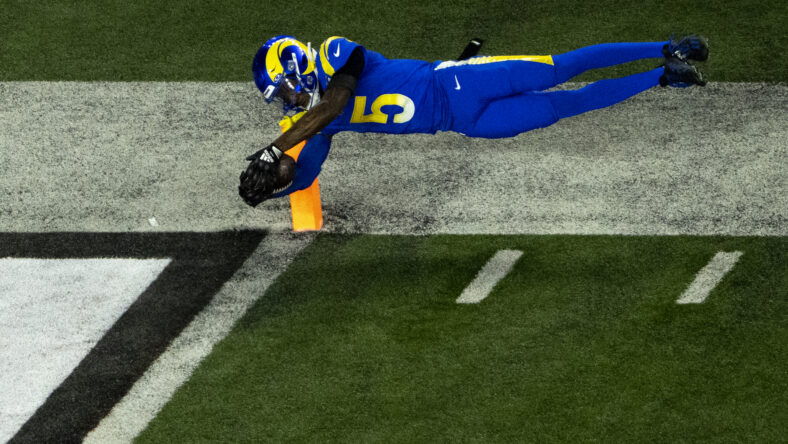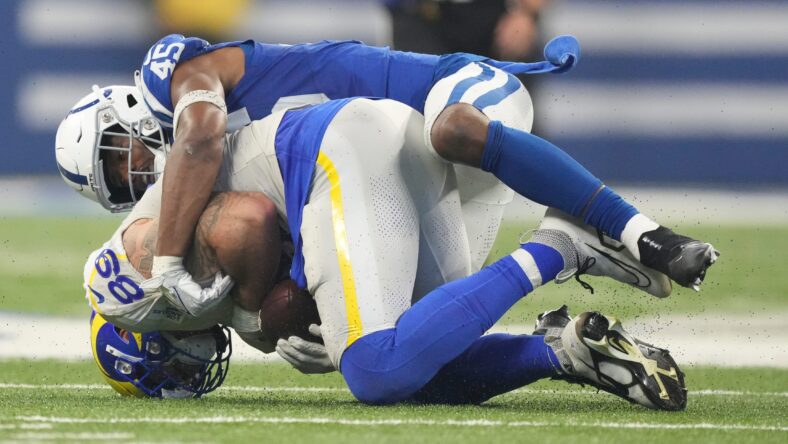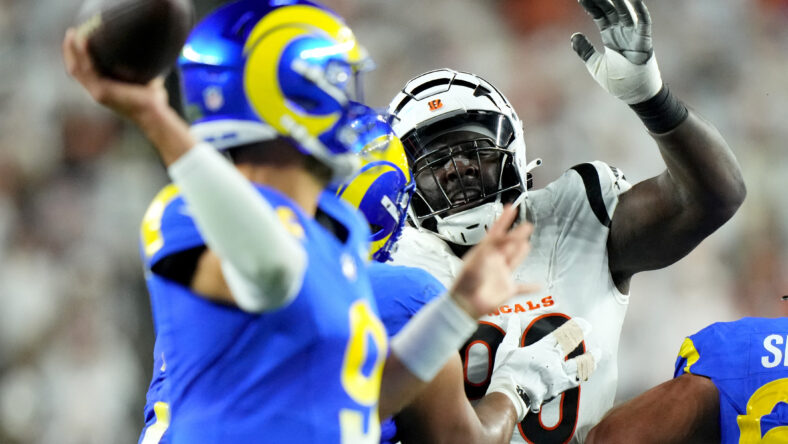It may come as a surprise, but the Los Angeles Rams offense under Matthew Stafford has the 10th-highest offensive expected points per play (EPA/play) in the NFL. But that isn’t the case when blitzed. They are blitzed 26 percent of the time and become the 20th-ranked offense by EPA/play when the defense sends five or more pass rushers.
All three of the Rams opponents during the current losing streak are among the top-10 blitzing teams in the league. Not many quarterbacks get better under pressure and Stafford is no different. In fact, when it comes to completion percentage Stafford drops off dramatically, from nearly 70 percent to 38. That’s 37th among qualifying quarterbacks. A stat that doesn’t change for Stafford is his average depth of target (ADOT). His ADOT this season is 8.9 yards, when blitzed it is 8.4. This means that Stafford is essentially attempting the same passes when being blitzed as when he is in a clean pocket.
That is why his completion percentage drops so percipiticly. The degree of difficulty of his passes remains the same even when defenders are bearing down. There are a few places the Rams could look to to help solve this problem.

Screen Passes
Screen passes are a quarterbacks best friend against the blitz. For one they are easier to complete. Two; because the defense is committing more players to the pass rush, there is more space for the receiver to pick up yards after the catch, especially on screen passes.
Stafford has attempted only 28 passes behind the line of scrimmage this season, which puts him 28th in the league. Puka Nacua has been the preferred target behind the LOS. But he has been ineffective in this respect. He has seven catches for 21 yards. This isn’t to say that the Rams don’t have options that are better in the screen game. Kyren Williams has 6 catches for 7.3 yards per catch and Darrell Henderson has 3 catches for 16.3 yards per.
Running backs are often the first option in the screen game, but speedy receivers are as well. Tyreek Hill and Ja’Marr Chase lead all wide receivers in yards this season.
It just so happens that the Rams have one of the leagues fastest wide receivers on their roster. Tutu Atwell is as speedy as they come. The Rams have only targeted Atwell twice this season behind the line of scrimmage, but the end around that he nearly took to the end zone against the Bengals is evidence of his ability to create explosive plays from behind the line of scrimmage. The key to this was getting him up to speed before crossing the LOS.
Screen passes have never been a major emphasis of the Rams offense, but this season has seen a significant drop-off and it is one of the reasons for their struggles against the blitz.

Working The Tight End Back Into the Rams Offense
This is a tougher nut to crack. In the post-Todd Gurley era, Tyler Higbee has been a go-to to pick up 5-7 yards and get a much-needed first down. From 2018-2021, a little over half of all of Tyler Higbee’s targets resulted in a first down. Last year it was only 30 percent and this it is 35 percent.
The responsibility of this decline is threefold, an uptick in drops (that’s on Higbee), a decrease in accuracy (that’s on Stafford. Sort of.), and a schematic shift (that’s on McVay).
The Rams recently extended Higbee, signaling their commitment to him as the starter in the foreseeable future. So in terms of the drops, he’s on the field for better and worse. The Rams have tried and failed to add other tight ends to the mix. So Tyler Higbee it is.
The other two factors work hand in hand. The visual that is conjured when thinking about Higbee is catching the ball 5 yards down the field with nary a defender in sight. That isn’t happening as much anymore. Defensive rules about who is covering tight ends have changed which have evened out the spacing and the mismatches that Higbee could take advantage of. The teams that have success with catching tight ends play a more physical brand of football with a hammering running game and a second physical pass catcher. Think A.J. Brown and Deandre Swift/ Christian McCaffrey and Deebo Samuel
In 2019, Tyler Higbee was third in the league in separation at the catch point. He is now 45th. But that drop also holds true for most tight ends across the board. The position is in flux and Sean McVay hasn’t adjusted to the shift. That’s why Stafford’s completion percentage to Higbee is so low. Higbee isn’t as open as he used to be and he is being covered by linebackers more often rather than safeties and corners.
Luckily, the Rams have a physical over-the-middle pass catcher, Puka Nacua, and an effective running game. McVay has to commit to using those weapons in a consistent, measured, and bruising fashion. That forces defenses to account for those players on third down and opens up room for Higbee.

Fixing The Rams Offense Against the Blitz
Teams like to blitz on third down and in obvious passing situations. When you put those together, you have the ideal situation to send the house at Stafford. The best way to defeat the blitz is not to put yourself in those high-leverage situations. That is to say, take care of business on first and second down. And when the Rams offense finds itself in those situations, they have to make defenses pay with explosive plays. Screen passes and getting Tyler Higbee open will help the Rams offense do just that.
Defenses have been blitzing the Rams offense more because it is effective. In 2021, Stafford was blitzed 8 times per game on average. This season that is up to almost 12 times per game. Even teams that don’t blitz are sending 5 or more rushers against the Rams offense.
The Rams offense has proven that he can do that by stretching the defense over the top. Now they have to prove he can do it underneath as well.
